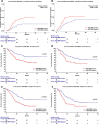Clinical impact of panel-based error-corrected next generation sequencing versus flow cytometry to detect measurable residual disease (MRD) in acute myeloid leukemia (AML)
- PMID: 33558666
- PMCID: PMC8102181
- DOI: 10.1038/s41375-021-01131-6
Clinical impact of panel-based error-corrected next generation sequencing versus flow cytometry to detect measurable residual disease (MRD) in acute myeloid leukemia (AML)
Abstract
We accrued 201 patients of adult AML treated with conventional therapy, in morphological remission, and evaluated MRD using sensitive error-corrected next generation sequencing (NGS-MRD) and multiparameter flow cytometry (FCM-MRD) at the end of induction (PI) and consolidation (PC). Nearly 71% of patients were PI NGS-MRD+ and 40.9% PC NGS-MRD+ (median VAF 0.76%). NGS-MRD+ patients had a significantly higher cumulative incidence of relapse (p = 0.003), inferior overall survival (p = 0.001) and relapse free survival (p < 0.001) as compared to NGS-MRD- patients. NGS-MRD was predictive of inferior outcome in intermediate cytogenetic risk and demonstrated potential in favorable cytogenetic risk AML. PI NGS-MRD- patients had a significantly improved survival as compared to patients who became NGS-MRD- subsequently indicating that kinetics of NGS-MRD clearance was of paramount importance. NGS-MRD identified over 80% of cases identified by flow cytometry at PI time point whereas FCM identified 49.3% identified by NGS. Only a fraction of cases were NGS-MRD- but FCM-MRD+. NGS-MRD provided additional information of the risk of relapse when compared to FCM-MRD. We demonstrate a widely applicable, scalable NGS-MRD approach that is clinically informative and synergistic to FCM-MRD in AML treated with conventional therapies. Maximum clinical utility may be leveraged by combining FCM and NGS-MRD modalities.
Conflict of interest statement
The authors declare that they have no conflict of interest.
Figures



References
-
- Estey E, Dohner H. Acute myeloid leukaemia. Lancet. 2006;368:1894–907. - PubMed
Publication types
MeSH terms
Grants and funding
LinkOut - more resources
Full Text Sources
Other Literature Sources
Medical
Research Materials
Miscellaneous

